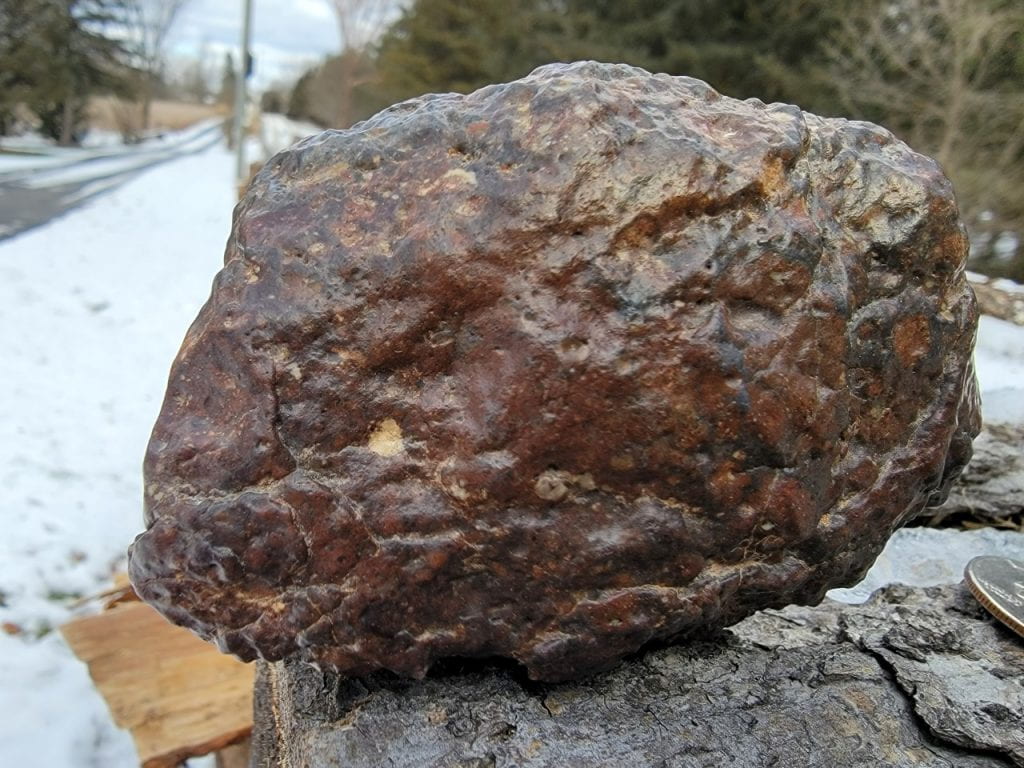Terrestrial rinds, coatings, and crusts
Many Earth rocks have crusts, but not fusion crusts
Most of the photos below were all sent to me by persons who thought that the coatings were meteorite fusion crusts. In my opinion, none of the rocks in the photos has a fusion crust.
Meteorite fusion crusts are thin because as soon as the exterior of the meteorite melts, the liquid is sloughed off due to of the high velocity of travel of the meteoroid through the atmosphere. The fusion crust does not build up, except perhaps on the trailing side. Meteorite fusion crusts are rarely greater than 1-2 mm thick.
On freshly fallen meteorites fusion crusts are usually smooth and glassy, although they might be rougher if the meteorite broke apart during atmospheric entry. On ordinary chondrites (87% of stony meteorites), they are usually usually black, although they might be reddish on weathered meteorites. Except under special conditions that do not often occur in temperate climates (U.S., Canada, Europe) meteorite fusion crusts do not “wear off” with time.
Terrestrial processes, most notably weathering, chemical deposition, and desert varnish, can produce rinds, coatings, and crusts on rocks that are often mistaken for meteorite fusion crusts. Typically, however, such rinds are thicker than meteorite fusion crusts. Sometimes these coatings are shiny like meteorite fusion crusts. Meteorite fusion crusts are shiny because they are glassy. None of the coatings in the photos below are glassy.
Hematite coatings
Iron dissolved in water will precipitate onto rocks often forming thick coatings of hematite or iron oxyhydroxides. The coatings may resemble meteorite fusions crusts but are often much thicker. I have not actually seen any of the rocks in the photos, but I think the coatings are all chemical deposits of hematite. Hematite coatings often flake off.



Onion-skin weathering
Another process that leads to features that are often mistaken for meteorite fusion crusts is onion-skin weathering or spheroidal weathering. Again, the layers on the rocks in the photos below are much too thick to be meteorite fusion crusts. Also, they are not glassy. Fusion crusts do not flake off like the exterior layers of rocks in the photos below.



Every “rule” has exceptions. Here is a photo of a real meteorite with a thick fusion crust: Ornans. Notice, however, that the crust is not hematite colored and that it is considerably darker than the interior of the rock – the crust is really a crust, not a coating.
Chemical weathering
Over thousands of years the exterior of any crystalline rock will interact with water and air to form rinds of a different color.

Desert varnish
Desert varnish is a special case of chemical weathering that happens to rocks exposed in arid deserts. The coating is very thin, about a micrometer thick and usually reddish to black in color. For small rocks in the desert, the exposed top has a varnish whereas the unexposed bottom does not.



Industrial coatings
See ferromanganese.